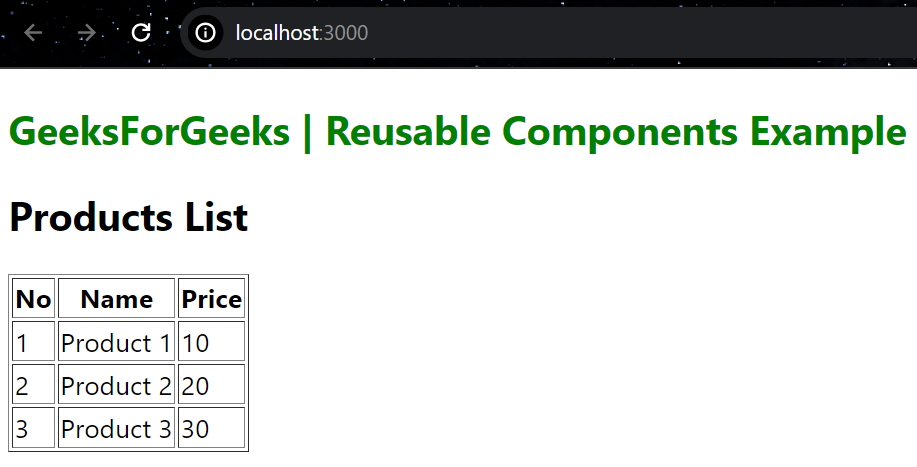How to make Reusable React Components ? (original) (raw)
Last Updated : 24 Jun, 2025
ReactJS is aJavaScript **library used to build **single-page applications (SPAs). React makes it easy to create an interactive user interface by using a **component-based approach. In this article, we will learn about **Reusable React Components with **examples.
Table of Content
What are Reusable React Components ?
**Reusable **React Components are pieces of code that can be **shared and **reused across different files in your application. It is a modular piece of UI that takes data from **propsto build complex and interactive user interfaces. It encapsulates the login that can be reused again.
Features of reusable components:
- It can accept props data to customize according to data.
- It can be used to encapsulate the same logic and reuse it again.
- It helps us to break the code into smaller units that can be reused again.
- It makes it easy to maintain the application.
How to make Reusable React Components ?
When creating reusable React components, it's important to keep in mind two key factors:
1. Avoid side Effects:
It is not recommended to include logic that interacts with external data, such as making API calls, directly inside a reusable component. Instead, you should pass this logic as props to the component.
For example, if a button not only has a visual function but also fetches data from the internet, it may not be reusable in other contexts.
In this case, we have a reusable button component that lacks best practices. In the example section, I will demonstrate why this is the case.
// It is a Reusable ButtonReusable component and this is a bad practicesconst ButtonReusable = () => { return ( <button> Click Me </button> );}
2. Use Props:
Props are parameters passed to a component to customize its behavior and appearance, making it reusable for different purposes.
// It is a buttonReusable component that can change its colorconst ButtonReusable = ({ color }) => { return ( <button style={{ backgroundColor: blue }}> Click Here </button> );}
This is considered bad practice because the label on the button is fixed as "**Click Here". If you wish to change the text on your button to, for example, "**Sign Up", you would have to go back to the button component and make that change. This means that every time you want to use a different text, you would have to edit the code again. In other words, the button would no longer be reusable.
To optimize performance in reusable React components, you can use **memoization to avoid unnecessary re-renders. React's React.memo and useMemo hooks allow you to cache the result of a component or calculation, ensuring that the component only re-renders when necessary. For more details, check out this memoization guide.
Steps to Create a React Application:
**Step 1: Create a React application using the following command:
npx create-react-app gfg
**Step 2: After creating your project folder(i.e. gfg), move to it by using the following command:
cd gfg
**Example: This below example demonstrate the Reusable React Components.
In this example, You can see **ProductList and **ProductItem component can be composed together and accept **props for customization and are reusable with different data sets.
App.js `
//File path: src/App.js import React from 'react'; import ProductList from './ProductList.js';
const App = () => { const products = [ { id: 1, name: 'Product 1', price: 10 }, { id: 2, name: 'Product 2', price: 20 }, { id: 3, name: 'Product 3', price: 30 }, ];
return (
<div style={{ margin: '5px' }}>
<h2 style={{ color: 'green' }}>
GeeksForGeeks | Reusable Components Example
</h2>
<ProductList products={products} />
</div>
);};
export default App;
ProductList.js
//File path: src/ProductList.js import React from 'react'; import ProductItem from './ProductItem.js';
const ProductList = ({ products }) => { return (
Products List
| No | Name | Price |
|---|
export default ProductList;
ProductItem.js
//File path: src/ProductItem.js import React from 'react';
const ProductItem = ({ product }) => { return (
export default ProductItem;
`
**To run the application use the following command:
npm run start
**Output: Now go to **http://localhost:3000 in your browser
